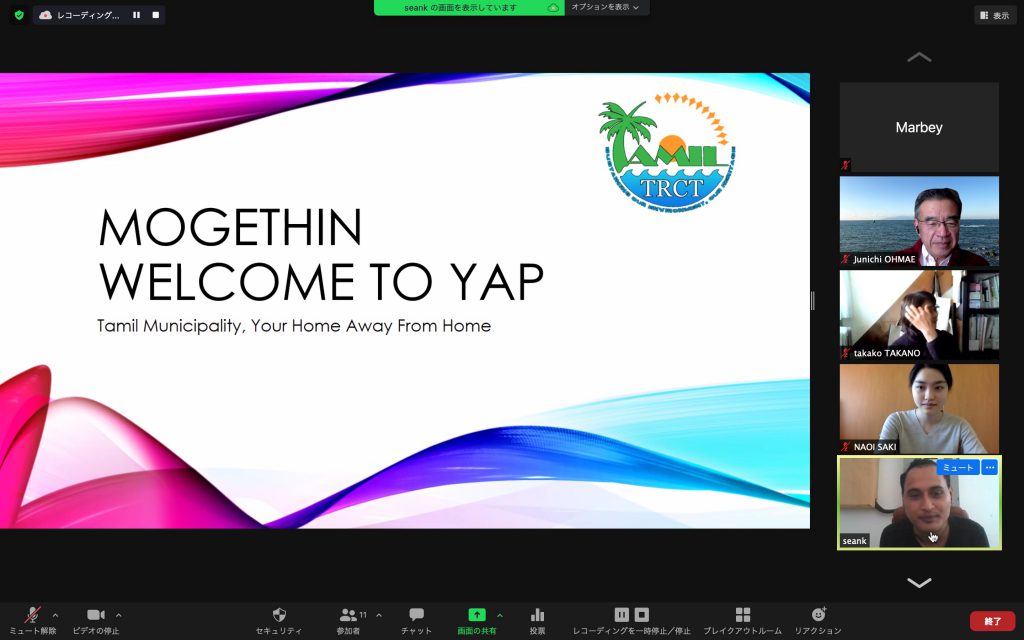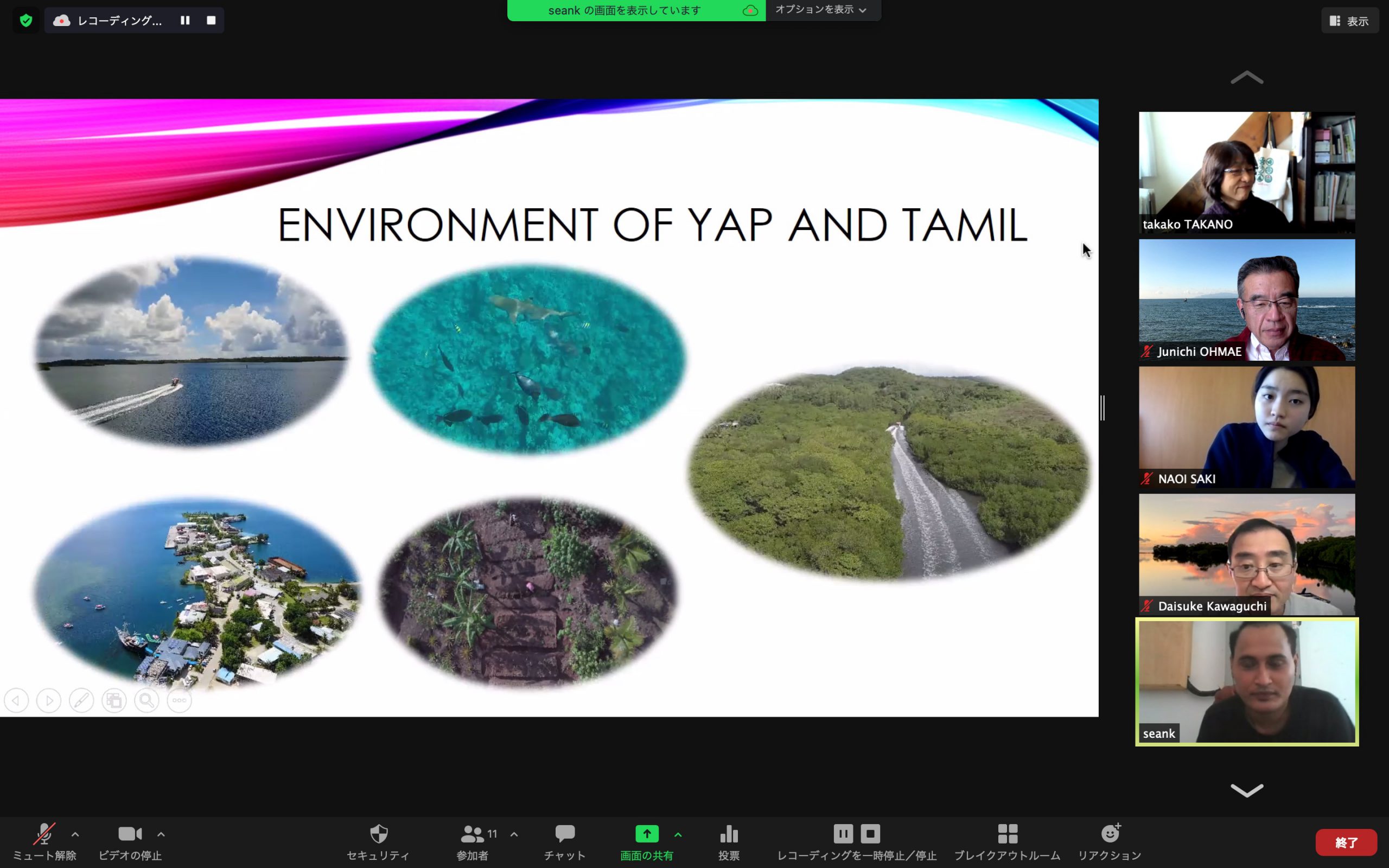The First Online Conference connecting Micronesian Island and Japan for Sustainable Future
2021年2月20日(土)にヤップ島と日本を繋ぐ初のオンライン交流会が開催されました。ヤップ島を含む太平洋の島々からヤップ側が5名、日本から過去のヤップ島プログラム参加者ら8名が参加しました。
ヤップ側の5人は、ショーン(仕事で訪れているチューク州から)、エン(勤務先のポンペイ州から)、ティナ(滞在先のグアムから)、そしてマルベイとケンがタミル地区からと、ミクロネシア各地からの参加でした。
The first online conference connecting Yap and Japan was held on Saturday, February 20, 2021. Islanders of Yap joined the conference; Sean Gaarad was from Chuuk, Ivan En was from Pohnpei, Tina Filled was from Guam, and Jeff Marbey and Ezekiel Ken from Yap. From Japan side, in total of 8 persons including ex-participants of Yap-Japan Cultural exchange program joined.
交流会では、経団連自然保護基金の支援によって行われているプロジェクト「タミルの持続可能な将来計画作り」について、現地からの報告と全体でのディスカッションを行いました。
The theme was “How to realize the sustainable society of Tamil municipality, Yap”. In the conference, we had a presentation by Sean and live reports from ocean side of village of Maaq and Merur in Tamil. It was a part of the project called “Sustainable Tamil,” supported by Keidanren Nature Conservation Fund, Japan.
最初に、参加者同士が自己紹介をした後に、ヤップ島のマ村とメルール村からスマホのカメラによる生中継が行われました。
ヤップ島には2019年に光ケーブルが陸揚げされ、インターネットが高速化しましたが、島内のネットワークがまだ弱く、画像は途切れ途切れ。しかし、波や風の音が聞こえ、メンズハウスの様子がリアルタイムで映し出されると、日本側の参加者はびっくり。過去参加者の中には20年近いギャップがある人もいましたが、それぞれ懐かしいヤップの景色と風を感じました。
Although Yap now has a submarine fiber optical cable connection since 2019, its local network is still depending on ADSL connection using metal cables. So the connection was unstable, however, viewers from Japan could see the views around their familiar men’s houses with the sound of wind and waves. Participants, some of those joined the program about two decades ago, had very memorable time over the screen.
次に、プロジェクトの中心メンバーであるショーンより、タミル地区の紹介と、プロジェクトの現状報告がありました。
First, Sean, a core member of the project, introduced the Tamil municipality and reported on the current status of the project.
The cultural characteristics of Tamil are that they respect each other, history and culture are inherited in practical ways such as oral tradition and dances, the community cooperates for a common purpose, and the existence of the family is very important.
タミル地区の文化的な特徴は、お互いに尊敬すること、文字がないため口承や踊りなどの実践的な方法で歴史や文化が引き継がれていること、コミュニティが共通の目的のために協力すること、そして家族の存在をとても大切にすることです。
そんなタミル地区で計画されている「エコツーリズム」は、島を訪れる人にもコミュニティ全体にも意義があり、環境や社会への負荷が少ない持続可能な「観光」のあり方を創造することを目指しています。
In the project, a trial of “ecotourism” was set as one of main goals. Ecotourism aims to create a sustainable tourism that has less impact on the environment and society. In other words, it seeks to benefit both visitors and the community as a whole.
タミル地区では自分たちの回りに、どのような「宝物」があるのかを見つけるために、村歩きが行われています。ショーン自身も知らなかった地域の歴史や自然環境の特徴などを村の他の人から学ぶ機会になり、多くの発見があったそうです。マ村とメルール村ではホームステイやグループステイの受け入れ態勢を構築中。訪問者に提供する食事についての話し合いも行われるとのことでした。
To begin with the preparation for ecotourism, villagers walked around each village to identify the ‘gems’ which are valuable to themselves and also to the visitors. It was meaningful for villagers to learn some histories and natural characteristics in the area.
In addition, it was reported that Maaq and Merur village were ready to host both homestay and group-stay visitors. It was also informed that meetings, about what food would be provided to visitors, would be held in coming weeks.
最後のディスカッションでは、ショーンから「文化、自然環境、人、宿泊施設、アクティビティ」5つのキーワードのうちどれが一番、人々の関心を引くことができると思いますかと問いかけがあり、それについて日本からの参加者が意見を出し合いました。
There is not something “Always showcased luxury” in Tamil but there is something in the living life that can amaze visitors. For instance, fruits, scenery, local dance and so on. In the final discussion, Sean asked Japanese participants which of the five keywords “culture, natural environment, people, accommodation, activities” would be the most interesting to people. The participants from Japan exchanged their opinions to answer the question.
日本人参加者からは以下のような指摘が出されました。
- 5つ全ての要素を貫くような体験が良いのではないか。
- いわゆる「観光客」ではなく、本質的な学びを期待する人たちを対象にしたらどうか。
- 地元の子供や若者を巻き込むことで、外から来た人たちがヤップの文化をどのように評価しているのかを知る機会になるのではないか。
- ヤップの人々がどのように関わり合っているのかを知ることが一番インパクトがあり重要ではないか。
- アクティビティはお金を払ってやるようなものではなくて、星空の下で海に入るなどのヤップにいることを感じることが大事ではないか。
- どこまでローカルにするかが課題。初めて訪れた人にとっては、トイレやシャワーなどの最低限の設備も必要になるはず。
Feedback from Japanese participants:
- All of the 5 elements are important. To integrate whole experiences would be important.
- Target the visitors not like the people who come to Colonia as a ‘tourist’, but those who really want to learn from the locals.
- It is good to invite local children and youth to the ecotour. It will be a good opportunity even for them to know how foreigners appreciate the local culture and nature they have, and visitors can also see how the cultures and wisdoms are inherited in Yap.
- To see how Yapese people are interacting with each other is the most impressive and important.
- It is important just to be in Yap, not buying experience.
- How much of the depth of the locality the host would provide to the visitors? For those who visit Yap for the first time, basic facilities such as toilets and showers would be needed or not…
こうしたフィードバックを受けて、ヤップ側からは、たくさんのお礼の言葉と共に、考えを深める機会になった、これから本格的にスタートしていきたいと意気込みが語られました。
新型コロナウイルスの影響によってエコツアーのトライアルなどは延期されていますが、日本と現地の往来が可能になれば、ヤップ島プログラムの参加者らを対象にしたエコツアーをすかさず実施する計画です。お楽しみに!(記録:猶井咲喜)
Although the project plan had to change due to Covid-19, it was a good opportunity to know the possibilities to connect online and share the information. (reported by NAOI Saki)






